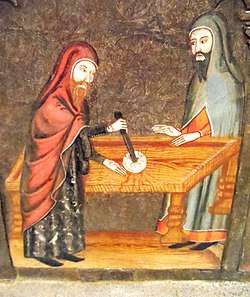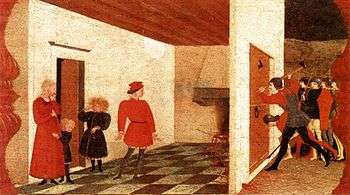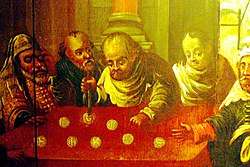Host desecration
Host desecration is a form of sacrilege in Christian denominations that follow the doctrine of the real presence of Christ in the Eucharist. It involves the mistreatment or malicious use of a consecrated host—the bread used in the Eucharistic service of the Divine Liturgy or Mass (also known by Protestants simply as Communion bread). It is forbidden by the Catholic, Oriental Orthodox and Eastern Orthodox Churches, as well as in certain Protestant traditions (including Anglicanism, Lutheranism, and Methodism). In Catholicism, where the host is held to have been transubstantiated into the body of Jesus Christ, host desecration is one of the gravest sins. Intentional host desecration incurs the penalty of excommunication latae sententiae.[1][2] Throughout history, a number of groups have been accused of desecrating the Eucharist, often with grave consequences due to the spiritual importance of the consecrated host.
Accusations against Jews were a common reason given for massacres and expulsions throughout the Middle Ages in Europe.[3] Similar accusations were made in witchcraft trials; witch-hunter's guides such as the Malleus Maleficarum refer to hosts as being objects of desecration by witches.[4] It is part of many descriptions of the Black Mass, both in ostensibly historical works and in fiction.[5]
Background

In Christianity, within the Anglican Church,[6] Catholic Church,[7] Eastern Orthodox Church,[8] Lutheran Church,[9] Methodist Church,[6] and Oriental Orthodox Church,[10] during the celebration of the Eucharist, the offerings of bread and wine are believed to become, by the action of God, the body and blood of Jesus — a doctrine known as the real presence of Christ in the Eucharist, a doctrine which has been believed from the earliest days of the Church.[11]
During the Middle Ages, Roman Catholic theology offered the concept of transubstantiation to explain this change of substance, which is believed to be actual and not merely symbolic. Transubstantiation, defined as a dogma at the Fourth Lateran Council of 1215, holds that the substances of the offerings are literally transformed, while the appearance of bread and wine remain. Most Christian Churches teach that Jesus is "true God and true man." In the Catholic Church, therefore, his "body, blood, soul and divinity" in the form of the consecrated host are adored. Theft, sale, or use of the host for a profane purpose is considered a grave sin and sacrilege,[7] which incurs the penalty of excommunication, which is imposed automatically in the Latin Church (See Code of Canon Law, Latin Church Code canon 1367, or Eastern Rite Code canon 1442.) [1][2]
Some denominations, especially Lutherans, have similar beliefs regarding the Eucharist and the Real Presence, though they reject the Roman Catholic concept of transubstantiation, preferring instead the doctrine of the sacramental union, in which "the body and blood of Christ are so truly united to the bread and wine of the Holy Communion that the two may be identified. They are at the same time body and blood, bread and wine...in this sacrament the Lutheran Christian receives the very body and blood of Christ precisely for the strengthening of the union of faith."[9] Both the Eastern Orthodox Churches and the Oriental Orthodox Churches, such as the Coptic Church, insist "on the reality of the change from bread and wine into the body and the blood of Christ at the consecration of the elements", although they have "never attempted to explain the manner of the change",[8] thus rejecting philosophical terms to describe it.[10] The Methodist Church similarly holds that Christ is truly present in the Eucharist "through the elements of bread and wine", but maintains that how He is present is a Holy Mystery.[6][12] Until the 19th-century Oxford Movement reintroduced the classic doctrine of the Real Presence, Anglicanism had favored receptionism — the doctrine that while the bread and wine in the Eucharist continue to exist unchanged after consecration, the faithful communicant receives together with them the body and blood of Christ.[13] Whatever the doctrine selected, among Anglicans the consecrated bread and hosts are reserved and treated with great reverence.
Since the publication of Memoriale Domini in 1969,[14] the Catholic Church has allowed certain countries to allow communicants to receive the Host in the hand, rather than directly onto the tongue, reviving an "ancient custom."[14] Communion in the hand is now widespread in many parts of the world. The practice means that access to consecrated Hosts is easier than in the past, since the person receiving it in the hand may pretend to place it in their mouth for consumption. However, the statements and practices of Pope Benedict XVI[15] caused a shift in Catholic practice (notably at Papal Masses and amongst more traditional-minded Catholics) back toward receiving on the tongue while kneeling. (Receiving on the tongue is still the official norm of the Catholic Church, while receiving in the hand [via the Memoriale Domini indult] is, in English-speaking countries, the practical norm.) Kneeling to receive communion is still the norm among Anglicans and Lutherans.
Medieval accusations against Jews

Accusations of host desecration (German Hostienschändung) leveled against Jews were a common pretext for massacres and expulsions throughout the Middle Ages in Europe.[3] The libel of "Jewish deicide": that the Jewish people were responsible for the killing of Jesus, whom Christians regard as God become man, was a generally accepted Christian belief. It was spuriously claimed that Jews stole hosts (objects to which they attached no significance, religious or otherwise), and further spuriously claimed that they abused these hosts to re-enact the crucifixion of Jesus by stabbing or burning them.
It has been asserted by modern scholars, such as the Catholic priest Gavin Langmuir, that these accusations against Jews represented profound doubt about the truth of Christianity.[16] Although the doctrine of transubstantiation did not imply that, by consuming the host, Christians were eating flesh and drinking blood in the normal sense, the language used to describe the dogma would have been interpreted as completely alien to Judaism and Jewish law. For Jews, such a belief system would contradict their strict dietary laws, which forbid the consumption of blood; even when consuming kosher animals.
Jews in the Middle Ages were frequently victims of similar accusations, considered more serious than desecration of other revered items, such as relics or images of Jesus and the saints. The accusations were often supported only by the testimony of the accuser, who may potentially bear a prejudice against the accused Jew or the Jewish people. Despite this, some alleged perpetrators were tried and found guilty, on little evidence or through torture.[3]

The penalties for Jews accused of defiling sacred hosts were severe. Many Jews, after accusations and torture, "confessed" to abusing hosts, and the accused Jews were condemned and burned, sometimes with all the other Jews in the community, as happened in Beelitz in 1243,[17] in Prague in 1389,[18] and in many German cities, according to Ocker's writings in the Harvard Theological Review.[19] According to William Nichol, over 100 instances of Jews pleading guilty to the desecration of sacred hosts have been recorded.
As mentioned above, the first recorded accusation was made in 1243 at Beelitz, south of Potsdam.[20] Tradition records that as a consequence the Jews of Beelitz were burned on a hill before the Mill Gate, which was subsequently, and until 1945, called the Judenberg, although there is no contemporary evidence for the burnings in documents of the 13th century. Another famous case that took place in 1290, in Paris, was commemorated in the Church of the Rue des Billettes and in a local confraternity. The case of 1337, at Deggendorf, celebrated locally as part of the "Deggendorfer Gnad" until 1992, led to a series of massacres across the region. In 1370 in Brussels the charge of host desecration, linked to an actual recovered relic of desecrated hosts currently found in the Cathedral of St. Gudula and long celebrated in a special feast, and to artistic depictions also found in the cathedral, led to the burning of six Jews (other times given twenty) and, reportedly, the expulsion of the town's Jewish population (see Brussels massacre). In 1510, at Knoblauch in Havelland 38 Jews were executed and more expelled from Brandenburg.
An alleged host desecration in 1410, at Segovia, was said to have brought about an earthquake; as a result, leading Jews in the city were executed and the local synagogue was seized and re-dedicated as the convent and Church of Corpus Christi.[21]
Similar accusations, resulting in extensive persecution of Jews, were brought forward in 1294, at Laa, Austria; 1298, at Röttingen, near Würzburg, and at Korneuburg, near Vienna; 1299, at Ratisbon; 1306, at St. Pölten; 1330, at Güstrow; 1338, at Pulkau; 1388, at Prague; 1401, at Glogau; 1420, at Ems; 1453, at Breslau; 1478, at Passau; 1492, at Sternberg, in Mecklenburg; 1514, at Mittelberg, in Alsace; 1556, at Sochaczew, in Poland. The last Jew burned for stealing a host died in 1631, according to Jacques Basnage, quoting from Manasseh b. Israel. In some cases host desecration legends emerged without actual accusations, as was the case of the host desecration legend of Poznan (Posen).[22]

The accusation of host desecration gradually ceased after the Reformation when first Martin Luther in 1523 and then Sigismund August of Poland in 1558 were among those who repudiated the accusation. However, sporadic instances of host desecration libel occurred even in the 18th and 19th century. In 1761 in Nancy, several Jews from Alsace were executed on a charge of sacred host desecration. The last recorded accusation was brought up in Berlad,[23] Romania, in 1836.[3]
2008 controversy in the US
In his July 8 blog entry, University of Minnesota Morris biology professor Paul Zachary Myers criticized the reaction to a University of Central Florida student's perceived act of host desecration (the student had attempted to bring the host to a friend who was curious about communion). Myers described the level of harassment against the student and expressed his intent to desecrate the host, which the Catholic Church considers grave matter.[24]
Myers expressed outrage that Fox News appeared to be inciting viewers to cause further problems for the student, and ridiculed reports that armed guards would attend the next Mass. Myers suggested that if any of his readers could acquire some consecrated Eucharistic hosts for him, he would treat the wafers "with profound disrespect and heinous cracker abuse, all photographed and presented here on the web."[25]
A number of Catholics immediately reacted strongly. William A. Donohue of the Catholic League accused Myers of anti-catholic bigotry,[26] described his proposal as a threat to desecrate what Catholics hold to be the Body of Christ, and sent a letter asking the University of Minnesota and the Minnesota State Legislature to take action against Myers.[26][27]
Myers pierced a host with a rusty nail, which he also used to pierce a few ripped-out pages of the Quran and The God Delusion, put them all in the trash along with old coffee grounds and a banana peel.[28] He provided a photograph on his blog of these items in the garbage and wrote that nothing must be held sacred, encouraging people to question everything.[28] In addition, he described the history of allegations of host desecration, emphasizing the frequent use of such allegations in medieval Europe to justify anti-Semitism.[28]
According to Donohue, as the Pharyngula website was accessible via a link from the University of Minnesota website, it should be bound by the institution's code of conduct which requires faculty to be "respectful, fair and civil" when dealing with others.[27] Subsequently, Myers explained to the Star Tribune that while his post was "satire and protest", he had received death threats regarding the incident but was not taking them too seriously.[26] The University of Minnesota, Morris (UMM) Chancellor defended Myers, and stated: "I believe that behaviors that discriminate against or harass individuals or groups on the basis of their religious beliefs are reprehensible" and that the school "affirms the freedom of a faculty member to speak or write as a public citizen without institutional discipline or restraint."[29]
Al-Islam magazine
In 2009, two Muslim reporters from Al-Islam, a small Malaysian magazine, participated in a Catholic Mass, while undercover writing an article on cases of apostasy from Islam (riddah) and received Holy Communion. The reporters afterwards spat out the Host and photographed it to prove they had not apostatised themselves.[30] The resulting photo was then published in their May 2009 edition.[31] The magazine, which is owned by Utusan Karya, part of the Utusan Malaysia Group, sent its reporters, including Muhd Ridwan Abdul Jalil, to two churches in the Klang Valley, as part of a special investigative report.[31] The act of desecration occurred at St Anthony's Church in Jalan Robertson, Kuala Lumpur.[32]
After its publication, two lay Catholics from Penang, Sudhagaran Stanley and Joachim Francis Xavier, jointly lodged a police report against the reporters.[33] The police took no action despite a potential charge under Section 298A (1) of the Penal Code for causing disharmony, disunity or feelings of enmity, hatred or ill will, or prejudicing the maintenance of harmony or unity, on grounds of religion.[31]
The desecration caused widespread outrage and condemnation from non-Muslims as well as Muslims[34] across the country. Parties including the Archbishop of Kuala Lumpur, Murphy Pakiam; the Catholic Lawyers Society; as well as numerous editorials in the media,[31] criticised the government and the Attorney-General for its failure to act.[35][36][37]
Some nine months later, in early March 2010, Al-Islam published an apology to the Catholic Church and other Christians for the article. It was posted on the website of its publisher.[38] Archbishop Pakiam, who is also president of the Catholic Bishops’ Conference of Malaysia, Singapore and Brunei, accepted the apology and said that no further (legal) action would be taken.[39]
Desecration during a Black Mass
A Black mass is a Satanic ritual designed to satirize or invert a traditional Catholic mass. Consecrated hosts are a common ingredient in black masses, becoming the subject of desecration. The hosts must first be stolen from the tabernacle of a Catholic church, and/or secreted away by people who are posing as parishioners receiving communion.
In 2014, the Dakhma of Angra Mainyu held a public black mass at the Oklahoma Civic Center[40] and planned to include the desecration of a consecrated host, which was to be "stomped on". That did not transpire: instead, the host was returned through an attorney after the archdiocese filed a lawsuit for its recovery.[41][42][43][44]
See also
References
Notes
- Code of Canon Law #1367
- Code of canons of Oriental Churches #1442
- "Desecration of the Host". www.jewishencyclopedia.com. Retrieved 7 May 2007.
- Summers, Montague, ed. The Malleus Maleficarum of Kramer and Sprenger, 1948. Originally in Latin, Germany, 1487. e.g. Part II, Question I, Chapter IV:"...they are bound to observe certain other abominable ceremonies at the command of the devils, such as to spit on the ground at the Elevation of the Host."
- See the studies by: Rhodes, H.T.F. The Satanic Mass, 1954 and Zacharias, Gerhard The Satanic Cult, 1980.
- Neal, Gregory S. (19 December 2014). Sacramental Theology and the Christian Life. WestBow Press. p. 111. ISBN 9781490860077.
For Anglicans and Methodists the reality of the presence of Jesus as received through the sacramental elements is not in question. Real presence is simply accepted as being true, its mysterious nature being affirmed and even lauded in official statements like This Holy Mystery: A United Methodist Understanding of Holy Communion.
- ""Sacrilege", Catholic Encyclopedia, 1912, retrieved 7 May 2007". Newadvent.org. 1912-02-01. Retrieved 2018-04-16.
- Harper, Brad; Metzger, Paul Louis (1 March 2009). Exploring Ecclesiology. Brazos Press. p. 312. ISBN 9781587431739.
- Mattox, Mickey L.; Roeber, A. G. (27 February 2012). Changing Churches: An Orthodox, Catholic, and Lutheran Theological Conversation. Wm. B. Eerdmans Publishing. p. 54. ISBN 9780802866943.
In this "sacramental union," Lutherans taught, the body and blood of Christ are so truly united to the bread and wine of the Holy Communion that the two may be identified. They are at the same time body and blood, bread and wine. This divine food is given, more-over, not just for the strengthening of faith, nor only as a sign of our unity in faith, nor merely as an assurance of the forgiveness of sin. Even more, in this sacrament the Lutheran Christian receives the very body and blood of Christ precisely for the strengthening of the union of faith. The "real presence" of Christ in the Holy Sacrament is the means by which the union of faith, effected by God's Word and the sacrament of baptism, is strengthened and maintained. Intimate union with Christ, in other words, leads directly to the most intimate communion in his holy body and blood.
- Houlden, James Leslie (2003). Jesus in History, Thought, and Culture: An Encyclopedia. ABC-CLIO. p. 185. ISBN 9781576078563.
The Copts are fearful of using philosophical terms concerning the real presence of Christ in the Eucharist, preferring uncritical appeals to biblical passages like 1 Cor. 10.16; 11.23-29 or the discourse in John 6.26-58.
- "Catholic Answers - The Real Presence (Fathers)". catholic.com. Archived from the original on 2011-05-25.
- Abraham, William J.; Watson, David F. (1 March 2013). Key United Methodist Beliefs. Abingdon Press. p. 1. ISBN 9781426771224.
Charles Wesley wrote a marvelous collection of hymns that offer an amazing vision of Christ's mysterious, yet real, presence in the bread and the wine.
- Cross, F. L., ed. (2005). "Receptionism". The Oxford Dictionary of the Christian Church (3rd ed.). Oxford University Press. ISBN 978-0-19-280290-3.
- "Memoriale Domini". www.ewtn.com. 1969-05-29. Retrieved 2020-07-20.
- Peter Seewald; Pope Emeritus Benedict XVI (2010). Light Of The World: The Pope, The Church and The Signs Of The Times. Ignatius Press. ISBN 9781586176068.
I am not opposed in principle to Communion in the hand; I have both administered and received Communion in this way myself... The idea behind my current practice of having people kneel to receive Communion on the tongue was to send a signal and to underscore the Real Presence with an exclamation point.
- Langmuir (1990), p.289
- Encyclopedia of Jewish knowledge. Behrman's Jewish book house. 1934. Retrieved 22 March 2016 – via Internet Archive.
- "Blood libel accusations against Jews", Religious Tolerance Organisation, retrieved 7 May 2007.
- Ocker (April 1998)
- "Desecration of Host". Jewish Virtual Library. Retrieved 2020-01-10.
- Markman, Sidney David (2003). Jewish Remnants in Spain: Wanderings in a Lost World. Mesa, AZ: Scribe Publishers. pp. 50–51. ISBN 0972723706.
- Magda Teter (2011). Sinners on Trial: Jews and Sacrilege after the Reformation. Harvard University Press. ISBN 978-0-674-05297-0.
- Loeb, Isidore (1877). La situation des israélites en Turquie, en Serbie et en Roumanie. J. Baer. p. 143.
- "College Student Gets Death Threats for Smuggling "Body of Christ"". Fox News. 2008-07-10. Retrieved 2016-08-22.
- "It's a Frackin' Cracker!". Pharyngula. 2008-07-08. Archived from the original on 2008-07-12. Retrieved 2008-07-11.
- "Communion wafer held 'hostage' raises holy heck". Star Tribune. 2008-07-11. Archived from the original on 2009-02-04. Retrieved 2008-07-11.
- "Minnesota Prof Pledges to Desecrate Eucharist". The Catholic League. 2008-07-10. Archived from the original on 2008-07-13. Retrieved 2008-07-11.
- Myers, PZ (July 24, 2008). "The Great Desecration". Pharyngula. Archived from the original on May 3, 2016. Retrieved May 19, 2016.
- WALSH, PAUL Morris chancellor defends instructor who defiled Eucharist, tore Qur'an Archived 2009-08-27 at the Wayback Machine Star Tribune, July 25, 2008
- Article "Al-Islam masuk gereja cari gadis bertudung murtad". May 2009 "Al-Islam enters a church seeking [muslim] girls hiding apostasy"
- AG should appreciate severity of Al-Islam incident: Catholic lawyers. (March 5, 2010). Yi Liang, Tan. The Sun. Retrieved March 15, 2010.
- Church unhappy A-G dropped 'Al-Islam' case. Archived 2010-03-08 at the Wayback Machine (Mar 5, 2010). Lourdes, Marc. New Straits Times. Retrieved March 15, 2010.
- Malaysian lay activist pursues ‘Al-Islam’ case Archived 2010-03-17 at the Wayback Machine (Feb 5, 2010). CathNews Asia. Retrieved March 15, 2010.
- Khairy condemns actions of two Al Islam journalists. Archived 2009-09-07 at the Wayback Machine (July 16, 2010). Syed Jaymal Zahiid. The Malaysian Insider. Retrieved march 15, 2010.
- Malaysia defends inaction over Catholic 'desecration'. (Mar 4, 2010). AFP. Retrieved March 15, 2010.
- Church: No action and no apology. (Mar 05, 2010). AsiaOne News. Retrieved March 15, 2010.
- Church slams govt over inaction. Mar 4, 2010. My Sin Chew. Retrieved March 15, 2010.
- Al-Islam apologises to Christians over special report. Mar 6, 2010. The Star. Retrieved March 15, 2010.
- Archbishop accepts apology, not suing Al-Islam. Archived 2010-03-17 at the Wayback Machine (Mar 8, 2010). Chong, Debra. Herald. Retrieved March 15, 2010.
- Blumberg, Antonia (22 September 2014). "Catholics Gather To Protest 'Black Mass' Event In Oklahoma City". Huff Post.
- Carla Hinton (21 August 2014). "Lawsuit pits Catholic archbishop against satanist group over sacred item purported to be used for 'black Mass'". newsok.com.
- "Satanists Return Stolen Host to Archbishop Coakley". ncregister.com. 21 August 2014.
- Brian Fraga (20 August 2014). "Archbishop Coakley Files Lawsuit Against Black Mass Organizers". ncregister.com.
- News9.com (21 August 2014). "Consecrated Host Returned, OKC Archbishop Drops Lawsuit". news9.com.
Bibliography
- Langmuir, Gavin I. (1990) History, Religion, and Anti-Semitism, Berkeley, California: University of California Press. ISBN 9781850432906
- Ocker, Christopher (April 1998) "Ritual Murder and the Subjectivity of Christ: A Choice in Medieval Christianity" Harvard Theological Review, v.91, n.2, pp. 153–192
Further reading
- Agosín, Marjorie and Sepúlveda, Emma (2001) Amigas: Letters of Friendship and Exile. Austin.

- Langmuir, Gavin I. (1990) Toward a Definition of Antisemitism. Berkeley, California: University of California Press. ISBN 9780520061446
- Marcus, Jacob Rader (1938) The Jew in the Medieval World: A Source Book: 315–1791, Atheneum. pp. 155–58. **Primary source in respect of the Christian atrocities against the Jewish community living in Passau, Bavaria, in 1478.
- Roth, Cecil (1997) "Host, desecration of". Encyclopaedia Judaica (CD-ROM Edition Version 1.0). Ed. Cecil Roth. Keter Publishing House. ISBN 965-07-0665-8
- Rubin, Miri (1999) Gentile Tales: The Narrative Assault on Late Medieval Jews. New Haven, Connecticut: Yale University Press. ISBN 9780300076127
- Stow, Kenneth (2006). Jewish Dogs, An Imagine and Its Interpreters: Continiuity in the Catholic-Jewish Encounter. Stanford: Stanford University Press. ISBN 0-8047-5281-8
- Trachtenberg, Joshua (1943) The Devil and the Jews: The Medieval Conception of the Jew and its Relation to Modern Anti-Semitism. New Haven, Connecticut: Yale University Press.
- Weiss, John (1995) Ideology of Death Ivan R. Dee, ISBN 1-56663-088-6
- Wistrich, Robert S. (1992) Antisemitism; The Longest Hatred. London: Mandarin. ISBN 9780749310783
External links
| Wikimedia Commons has media related to Host desecration. |

- Professor John Klier's review of Miri Rubin, Gentile Tales: The Narrative Assault on Late Medieval Jews
- Discussion of host desecration accusations in Poland by Magda Teter. See also the video on that site

